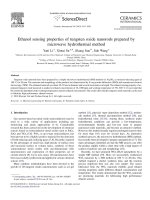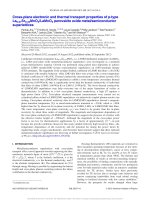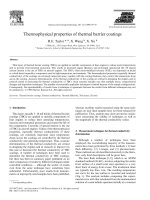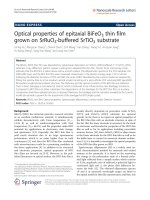- Trang chủ >>
- THPT Quốc Gia >>
- Hóa
Properties of matter
Bạn đang xem bản rút gọn của tài liệu. Xem và tải ngay bản đầy đủ của tài liệu tại đây (3.75 MB, 12 trang )
Physical Sciences
Standards
Preview
Standard Set 1. Physical Sciences
1. Energy and matter have multiple
forms and can be changed from
one form to another. As a basis for
understanding this concept:
of
1.i. Students know people once
thought that earth, wind, fire, and
water were the basic elements
that made up all matter. Science
experiments show that there are more
than 100 different types of atoms,
which are presented on the periodic
table of the elements.
by Lisa Oram
Genre
Nonfiction
Comprehension Skill
Sequence
Text Features
•
•
•
•
Captions
Labels
Table
Glossary
Science Content
Matter
Scott Foresman Science 3.3
ISBN 0-328-23524-5
ì<(sk$m)=cdfceh< +^-Ä-U-Ä-U
Vocabulary
atom
chemical change
element
evaporation
matter
melting
periodic table
property
of
by Lisa Oram
Picture Credits
Every effort has been made to secure permission and provide appropriate credit for photographic material. The
publisher deeply regrets any omission and pledges to correct errors called to its attention in subsequent editions.
Unless otherwise acknowledged, all photographs are the copyright of Dorling Kindersley, a division of Pearson.
Photo locators denoted as follows: Top (T), Center (C), Bottom (B), Left (L), Right (R), Background (Bkgd).
4 (T) Charles D. Winters/Photo Researchers, Inc., (B) Ken Cavanagh/Photo Researchers, Inc.; 7 (R) Hulton Archive Photos/
Getty Images; 10 (L) Robert Folz/Visuals Unlimited; 12 (BR) Charles D. Winters/Photo Researchers, Inc.;
13 (TR) Jeff Greenberg/PhotoEdit; 14 Getty Images; 19 Mauro Femariello/Photo Researchers, Inc.
ISBN: 0-328-23524-5
Copyright © Pearson Education, Inc. All Rights Reserved. Printed in the United States of America.
This publication is protected by Copyright, and permission should be obtained from the publisher prior to any
prohibited reproduction, storage in a retrieval system, or transmission in any form by any means, electronic,
mechanical, photocopying, recording, or likewise. For information regarding permission(s), write to
Permissions Department, Scott Foresman, 1900 East Lake Avenue, Glenview, Illinois 60025.
1 2 3 4 5 6 7 8 9 10 V010 13 12 11 10 09 08 07 06
What is matter?
This book is matter. Your pencil is matter. Your desk
is matter. Matter is anything that has mass and takes up
space. The mass of an object is how much matter it has.
Heavier objects have more mass. Lighter objects have less
mass. Pick up a ball. It is matter. The air inside a ball takes
up space. It is matter too.
A property is something about matter that you can
observe with one or more of your senses. Shape, color,
weight, size, smell, and taste are some properties. A book
might have a smooth cover and a square shape. These are
properties of that book.
FPO
2
3
Parts of Matter
Have you ever used aluminum foil? Aluminum foil is
matter made from particles of the element aluminum. An
element is matter made from a single type of particle
that is too small to see. Cut aluminum foil into many tiny
pieces. Each piece is still made of aluminum.
Matter can be made up of one element or more than
one element. A penny is matter. Pennies used to be
made only of copper. Now, pennies are made up of two
elements: copper and zinc.
A penny is matter.
Pennies used to be
made only of copper.
All matter is made up of atoms. An atom is the
smallest particle of matter that has the properties of an
element. Atoms are very small. You cannot see them with
your eyes or a regular microscope. Scientists form images
of them using special microscopes.
Look at a picture in a magazine. The colors appear
to be solid. Now, look at the same picture under a
microscope. All the many colors are made out of patterns
of tiny dots of only a few colors. The dots combine to
make the colors in the picture. Different kinds of matter
are made up of combinations of atoms in the same way.
Scientists use
special microscopes
to study atoms.
Today, pennies are
made of copper
and zinc.
4
5
Ideas About Matter
People have always wondered about their world. In
ancient times, people observed fire turn wood to ash. Gas
and smoke rose from the fire. Gas in the air turned to
water and rain. They concluded that earth, air, fire, and
water were the four elements that made up all matter.
Today, scientists know there are more than 100
elements. Matter can be made up of one element, two
elements, or many kinds of elements. Living things
are mostly made up of carbon, oxygen, nitrogen, and
hydrogen.
The periodic table is a chart that scientists use to
organize all the elements. Each element has a name and
a symbol. Some people who have discovered elements
have been allowed to suggest names for them.
Berkelium was named after the city of Berkeley,
California. What do you think californium is named after?
Einsteinium is named after Albert Einstein. Seaborgium
is named after another scientist, Glenn Seaborg. What
would you call an element named after you?
Albert Einstein (left) is seen here talking
about the periodic table with another
scientist.
6
7
What forms does
matter take?
Matter can exist in three forms: solid, liquid, and gas.
The particles in these three forms of matter are always
moving. The particles move differently in each form of
matter.
A baseball is a solid. It keeps its shape when it flies
through the air or rolls on the ground. Its particles are
firmly held together. They vibrate, but they stay in place.
Milk is a liquid. Its shape depends on what container
is holding it. The same amount of milk in a glass and in
a carton will have a different shape. The particles in a
liquid are loosely held together. They can flow past one
another.
Gas particles are not held together. They move freely
and bounce off each other. Air is a gas. It does not have
its own shape. When you pump air into a ball, the air fills
the space.
The air in this soccer ball
is a gas. Its particles are
not held together.
The ball and the glove are
solids. Their particles are
held tightly together.
This milk is a liquid.
Its particles are
loosely connected.
8
9
Heating Liquids
It rains, and the street is wet. Soon the street will be
dry, and all the puddles will be gone. Where does the
water go?
Heat changes the liquid water into water vapor.
Water vapor is a gas. This process is called evaporation.
Evaporation occurs when a liquid is changed into a gas.
When water is vapor, it is part of the air, so the street is dry.
Think about a hair dryer. Your hair will dry without
a hair dryer. But with a hair dryer, your hair dries faster.
The heat from the dryer speeds up the evaporation of the
water on your hair.
The water in this puddle has
started to evaporate.
10
11
Heating Solids
Heating Metals
Heat can also change solids. Frozen solids melt into
liquids when they get hot. Melting is changing from a
solid to a liquid. A frozen juice bar on a sunny day doesn’t
last long!
Carbon dioxide is a gas at room temperature. If
enough heat is removed, the gas changes to a solid called
dry ice. If it gains heat energy, the dry ice can turn into a
gas without first becoming a liquid.
Deep inside Earth it’s very hot. Because it’s so hot,
metal and rock at Earth’s center are liquid. This liquid is
called magma. After magma erupts from a volcano, it is
called lava. The lava will cool and become solid rock.
Gold and silver metals are used in liquid and solid
form. They can be made into jewelry. Jewelry makers
heat the metal and mold it into beautiful shapes. When
the shapes cool down, they become a hard solid.
Heat causes solids to
become liquids.
This jewelry maker
is shaping gold
using heat.
Dry ice
12
13
What are chemical
changes?
In chemical changes, one kind of matter changes
into a different kind of matter with different properties.
One type of cement begins as a dry powder. To use it,
you have to mix it with water. A chemical reaction takes
place when you make cement. A paste is formed that
dries into cement.
The cement cannot become a powder again. The
water cannot be taken out of the cement. Cement is not
the original matter in a different form. It is an entirely
new piece of matter with different properties.
Baking bread also causes chemical reactions. The
flour, baking powder, yeast, and eggs make a new
substance. When a piece of that bread is toasted, another
chemical change occurs. The bread changes color and
texture. You can’t turn toast back into untoasted bread.
A chemical change
happens when you
toast bread.
Cement holds these bricks
together. It can never be
turned back into powder
and water.
14
15
Physical Changes
Mixing Matter
A physical change is different than a chemical change.
In a physical change, the original matter keeps its original
properties.
During a physical change, matter can change form.
Water can freeze into ice. Ice can melt back into water.
The matter is water whether it is liquid or solid.
Have you ever mixed your favorite cereals? When you
pour them into a bowl they each stay the same. Their
properties don’t change. Each cereal looks the same.
They don’t combine to form a new type of matter.
The ingredients in trail mix stay the same too. When
you mix nuts and raisins together they remain nuts and
raisins. Like the cereal, they keep their shape and taste.
No chemical change takes place.
2
The water has frozen
into ice.
The ingredients in trail mix do not
change into new kinds of matter.
3
The ice is melting back
into water.
1
Liquid water
is poured into
the tray.
16
17
Chemistry in Our World
Chemical changes are happening everywhere around
you. Chemical changes are happening inside you too! Eat
an apple and your body changes the apple’s sugar into
energy and other kinds of matter.
Do you have toys with batteries? Chemicals inside
the batteries keep your toy train running or your music
playing!
18
Scientists who study chemistry are called chemists.
They help find solutions to many of the world’s
problems. They can develop medicines to cure diseases.
Plastic was even invented by chemists.
Chemistry is the study of matter. And chemistry
matters!
These chemists are performing
an experiment.
19
What did you learn?
Glossary
atom
chemical change
1. What is the smallest part of an element?
the smallest particle of matter
that has the properties of an
element
2. What are the three forms of matter?
a change in which one kind of
matter becomes a different kind
of matter
4.
You read about how heat
can affect liquids as well as solids and metals. Write a
paragraph that explains how heat affects different
kinds of matter.
5.
Sequence You read that cement is used to hold
bricks together. What are the steps you would take to
make cement and then use it in a brick wall?
element
matter made up of a single type
of atom
evaporation
when a liquid is changed into a
gas
matter
anything that has mass and takes
up space
melting
changing from a solid to a liquid
periodic table
a chart with elements arranged in
rows and columns according to
their properties
property
something about matter that can
be observed with one or more
senses
20
3. What is one example of a chemical change?









